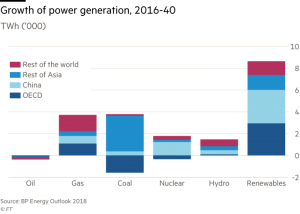 Cheaper new technologies make renewables competitive in fight against global warming.
Cheaper new technologies make renewables competitive in fight against global warming.
When BP’s economists published their annual review of world energy this week, the survey revealed a surprising statistic: 17 per cent of the world’s energy growth last year came from renewable sources, the largest increase on record. New installations of renewable energy were equivalent to the energy output of 69m tonnes of oil — about as much energy as Sweden and Denmark consume in a year.
This development might have been unthinkable a decade ago, when wind and solar power were much more expensive than they are today. However, a surge of investment in renewable energy sources over the past decade combined with falling costs for new energy technologies has brought about a profound transformation in global energy production.
Part of the reason for this massive shift was the Paris climate agreement, signed in 2015, when more than 170  countries agreed to reduce their emissions to limit global warming to below 2C. Much of the progress in curbing carbon emissions in the past five years has come from the growth of wind and solar power, which have experienced dramatic price reductions.
countries agreed to reduce their emissions to limit global warming to below 2C. Much of the progress in curbing carbon emissions in the past five years has come from the growth of wind and solar power, which have experienced dramatic price reductions.
Global investment in clean energy has risen over the past decade and hit a high of $179bn in 2015, according to BNEF, but it has remained below that level in the years since, primarily because of the falling investment in Europe and the Americas.
After levelling off between 2014 and 2016, global carbon emissions ticked up again last year, partly because of increasing energy consumption in China.
Despite this, Ms Figueres remains upbeat. “The long-term trend is toward decarbonisation,” she says. “We have had ups and downs, and we will continue to have ups and downs.”
Souce: “Surge in solar and wind power marks shift to low-carbon energy ”, Financial Times
